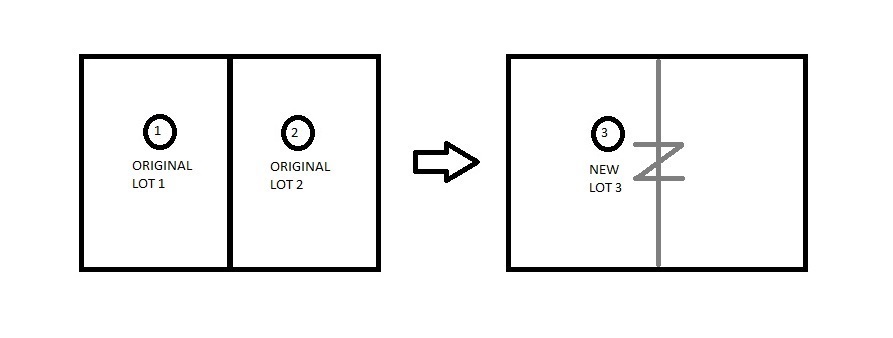The term “reverse subdivision” is something you may have run into during a search for information about general land subdivision. You may already know what a subdivision is and that it involves the dividing of property into smaller pieces. You may also know that a land subdivision also involves the preparation of a plan showing the proposed division of land. However, a reverse subdivision is slightly different.
A reverse subdivision, also sometimes referred to as a “lot consolidation”, is the combining of two or more parcels of land into a single parcel. It is what it sounds like. If a subdivision is the dividing of land, then a reverse subdivision is the opposite which is the combining, or consolidating, of land.
One thing that a regular subdivision and a reverse subdivision have in common is that they both require professionally prepared plans.
Reasons for Creating a Reverse Subdivision
The following are a couple of examples of when you might want to create a reverse subdivision.
1) You might have purchased many small adjacent lots over time that you now want to combine into one lot. Not only does this result in just one deed for the new single lot, but also having one larger lot could offer extra flexibility with regard to how you can build on that lot. You could have a larger lot with a larger buildable area. This would especially be the case if any of the smaller lots before the consolidation have particular land development issues such as wetlands, waterways, or steep slopes.
2) You want to purchase a neighboring property or a group of properties to add to your existing property in order to keep others from being able to build right next to your existing property.
3) You have a house on a small lot where you already have the maximum amount of impervious coverage allowed and would like to purchase an adjacent lot to combine with your existing lot. This larger lot could then allow you to construct a driveway extension, a building addition, or new separate buildings on your consolidated parcel.
There is also a special kind of reverse subdivision that involves both a reverse subdivision and a subdivision within the same plan. In this scenario, you might own many small adjacent parcels of land that you want to technically combine into one lot but then, right away and within the same plan, subdivide what would have been a single lot into smaller lots.
These smaller lots could be the same number of lots as the original lots or they can be a different number of lots than the original lots. However, the configuration of the new lots would be different from the original layout of the lots.
Advertisement
What Is Involved in Creating a Reverse Subdivision
As stated earlier, a reverse subdivision involves a professionally prepared plan. Once this plan is prepared by a licensed land surveyor or a civil engineering company that has licensed land surveyors, the final plan would have to be recorded at a local Recorder of Deeds office to make the plan official and legal.
Before a plan can be recorded, it would have to be reviewed and approved by the local municipality where the properties to be combined are located. The municipality would have a set of drafting requirements that would have to be met. The municipality would also have various zoning and subdivision ordinance requirements that the plan would have to meet.
Even though this is a reverse subdivision plan, the plan has to meet the requirements of the regular subdivision ordinance since you would technically still be creating a new lot with a different area and layout from the original lots. The requirements, based upon the most current subdivision ordinance, could include minimum lot area, maximum allowable building impervious area for the new lot, maximum allowable total impervious area for the new lot, and building setback lines for the new lot.
The maximum impervious area calculations would be based on the existing impervious area. However, knowing your existing impervious coverage numbers is important if you plan on building anything on your new consolidated lot because you would be able to calculate how much of your new lot area you have left that you can turn into impervious area before you reach the maximum impervious area allowed by the municipality ordinance.
Related: What Is Impervious Area in Land Development?
Once your new reverse subdivision plan is created and approved, a lawyer may also have to get involved with the preparation of the new deed for the new lot configuration.
Once the approved plan is recorded, someone responsible for the local GIS (Geographical Information System), if there is one, would then have to revise in the system the lot boundaries that are the result of your reverse subdivision plan.
The Plan Prepared for a Reverse Subdivision
The plan involved in the preparation of a reverse subdivision is very similar to the plan created for a regular subdivision. It would have the same elements such as a north arrow, a graphic scale bar, a legend, a title block, property boundary lines, and property boundary line bearing and distance information.
In a reverse subdivision plan, however, you would see a large “z” shape along whichever property boundary is being extinguished as part of the lot consolidation.
Advertisement
The Costs Involved With Preparing a Reverse Subdivision Plan
The preparation of a reverse subdivision plan should be generally less than the preparation of regular subdivision. The reason is because with a simple reverse subdivision, you are creating a smaller number of lots as opposed to creating a larger number of lots with a regular subdivision of land.
The costs associated with creating a lot consolidation plan involve the engineering and surveying time for any deed research for the existing parcels, the surveying of existing property boundaries, and the actual drafting of the plan. There are also the application fees and engineering review fees that may be charged by a municipality to review your plan for ordinance compliance. Another cost to consider is the cost to have the approved plan recorded.
Hire the Right Professional
Even though it may not involve as much work as a regular subdivision plan, a reverse subdivision plan can still be complicated enough to require a professional engineering or surveying company to help create your plan. This company would have the right equipment and licenses to properly prepare your plan.
Also, assuming you choose the right company, this kind of company would know from experience the various plan requirements of the reviewing municipality.



